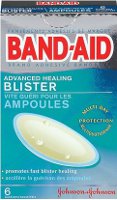How to treat and prevent blisters while kayaking
Blisters can be a common problem on thumbs and anywhere your hand touches the paddle. Water softens hands, making them more susceptible to blisters.
A blister can turn an enjoyable day on the lake into misery.
Prevention
The best way to treat blisters is by avoiding them in the first place. The best way to avoid blisters is to reduce friction. Here are a few ways to do that:
- Proper Grip: You should hold the paddle loosely in both hands. Holding on too tightly will increase friction and the likelyhood of blistering.
- Gloves: Gloves aren't necessary for kayaking, but they can help, especially on long trips. You can find decent kayaking gloves from ten to thirty dollars. It's well worth the investment if you plan on doing lots of paddling.
- Moleskin: Some kayakers who are prone to blisters will wrap pieces of moleskin onto common blister spots as a means of prevention.
Treatment
Treatment of the blister depends on the stage of the blister.
- Pre-blister: Before a blister forms often the skin start to look hot and red. Covering the area with a waterproof bandage will reduce friction and may help prevent a blister from forming. This may also be a good time to evaluate how you are gripping the paddle.
- Blister: Once a blister has been formed, draining the fluid in the blister may reduce the pain. Sterilize a needle with a flame or alcohol and pierce the blister from on the side. You can also use a knife to do this.
- Open Blister: Whether a blister has opened up on its own, or if it's been opened intentionally with a needle or knife, you will want to wash the blister with soap and water, and apply a water-proof bandage to keep the area from being infected. Try to keep the blister dry.


Comments